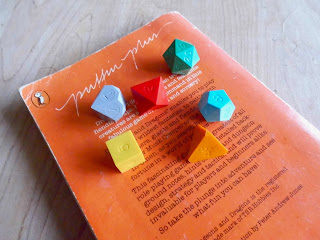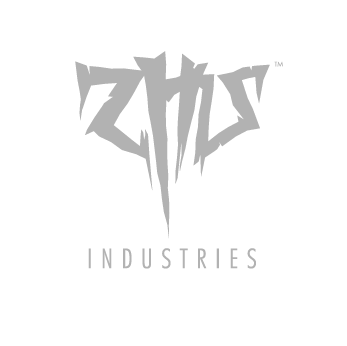Small project to create a dice set inspired by the work of renown fantasy artist
(PAJ) and more specifically his painting used for the front cover for the third edition of
by John Butterfield, Philip Parker and David Honigmann, published in 1984 by Puffin Books
No doubt it was marketed to libraries, schools and parents who wanted to get a handle on the latest 80s fad, and ensure themselves that
was more a harmless pastime that uses the imagination, weird dice for random number generation, and not a form of pseudo-satanism that the paranoid American religious-right was keen to promote as the existential threat of the week.
Today the book is, more or less, a piece of social documentary and evidence as to how D&D was being played by a small group of Etonian sixth formers in the early 1980s. The triumvate of teen-authors went on to write the
Cretan Chronicles series of Adventure Gamebooks, no doubt using their of Classics, before going on to get proper jobs as a Lawyer, Historian and music reviewer for the
Financial Times (at least I assume it's the same fellows). As FF author Paul Mason
observes public schoolboys betting publishing deals is all quite deeply embedded in the structures of the British class system, and such ostentatious display of privilege - and may well have been irksome to D&Ders on the other side of the social divide. Nonetheless, the gaming style described in
What is Dungeons & Dragons? means blending aspects of different versions of D&D (including
Basic, Expert and
Advanced) along with cherry-picking elements from
White Dwarf magazine, to create a specific melange of rules for the group, any pretence at playing 'official' or pure D&D is quietly ignored, and rightly so. If you want to know more about the inner-workings of the book
Muffin Labs has an extensive review.
I've had my copy of
What is Dungeons & Dragons? since 1984, and lugged around various school lunch-time groups, attic-bound gatherings of state-school role-players to throw at the DM. It recently emerged, along with 50 or so green-spined
Fighting Fantasy books from a storage box in the loft to form a bright lime rectangle, bookended with tangerine across the living-room wall in a brief spate of lockdown induced interior redesign adding an element of bold colour at once fresh and modern and yet entirely nostalgic and homely.
 |
| Peter Jones | Solar Wind | Paper Tiger 1980 |
PAJ remains undoubtedly one of the premier fantasy artists of the 1970s and 1980s, his vividly stylised air-brushed work combines highly saturated colour with a strong design sense to create immediately recognisable and dramatic images. His work appeared on many fantasy and science fiction novels, including works by Tanith Lee, Peirs Anthony, Robert E. Howard, and Frank Herbert amongst many others. PAJs work graced the covers of several classic
Fighting Fantasy game-books, including the inaugural
Warlock of Firetop Mountain (Puffin, 1982) making him an obvious choice for Puffin to commission for their "How to D&D" book. Inevitably his paperback paintings would surface again as covers for roleplaying games magazine
White Dwarf placing his repertoire firmly in the minds of a generation of gamers and PAJ would go on to produce box art for classic video games for visually-led publishers such as
Psygnosis, as the
D&D boom of the 1980s faded and the home-computer gaming scene took off in the UK.
 |
| What is Dungeons & Dragons? | Peter Andrew Jones | 1984 |
The cover of
What is Dungeons & Dragons? features a large purple and green head of a somewhat freudianly suggestive dragon psionically projecting regular polyhedra from his reptilian eyeballs. PAJs charictaristially dramatic use of colour is fully evident, balancing the deep crimson reds of the infernal background, with the smokey greens of the dragons head. The hard edged geometrical polyhedra held in dramatic tension with the organic, fluid forms of the dragon. The dragon herself appears potent yet static, an embodiment of primal chaos like the Tiamat of Babylonian myth, the undifferentiated matter of the cosmos being transformed into its initial order through the force of will. A dramatic visualisation of the physical world manifesting through the formation of the primary geometrical atomic building blocks - the two dimensional triangular radiation emitting from the generative dragon - forming the three dimensional molecular solids of the physical universe in Platonic philosophy. A creative expression of the primary mytho-cosmic act of creation and form-giving, we are reminded of Paul Cézanne's reduction of visual forms to their essential elements and the Bauhaus preoccupation with the graphic unity of abstract geometrical structures, form and colour.
And by the magic of online retail, these regular polyhedra have now, after some 36 years of draconic concentration, finally manifested themselves on the prime material plane:
 |
| A Custom What is Dungeons and Dragons Retro Dice Set |
Dice aficionados will recognise the set of polyhedra on the cover is not based on the
original Dungeons & Dragons dice nor the
TSR Dragon Dice, but is an entirely unique combination of colour and geometry. PAJs pallet for his polyhedra is an undeniably attractive one that balances warm and cold hues through the spectrum, but eschews more theoretical or esoteric application of light frequency to geometry to create a individualistic blend of form and colour. Unfortunately the original painting omits an icosahedron (d20) but we have taken the central Dragon motif as inspiration for the choice of green hue. The grey diamond form on the left hand side of the painting is not quite a pentagonal trapezohedron, but the diamond-kite shape strongly suggests one of the faces of the d10 - an innovation not mentioned in the text (the authors use a d20, marked 0-9 twice), and not part of the original D&D dice set, so represents something of a anomaly that nonetheless seems already anticipated by PAJs artwork.
Having determined what forms and colours were required for the set, it only remained to source the objects, most dice companies products have rounded corners (presumably for 'roll') and more often than not combine multiple colours of plastics to create swirled patterns or jewel-like transparent effects.
Gamescience have been making dice since the 1970s and have an extensive range of dice are famous for their hard edged precision, and have a flat, uniform colour that bucks the trend of the decorative marble-effect and gaudy glitter dice. The dice are available both with the numbers inked and non-inked, I opted for the non-inked to closer tie in to the artwork, but with ageing eyes have the option to ink in the numbers myself at some point. Overall the Gamescience dice very nicely encapsulate the abstract, mathematical purity of the polyhedra represented in PAJs painting and also supply a wide enough variety of colours to make selection possible.
Fortunately
Dice Shop Online are based in the UK, supply Gamescience dice, and most importantly, sell individual dice so individual colours and shapes can curated for bespoke projects such as this. For reference, links to each of the dice on DSO:
While I am pleased with my Custom Retro D&D Artist Dice Set, inspired by Peter Andrew Jones painting for "What is Dungeons and Dragons?", I wonder what other old school D&D or RPG artist inspired custom curated dice sets might there be out there. Perhaps the black dice with tiny skulled dots from John Blanche's Sorcery! or the particular set shown on the front cover of Ian Livingstones Dicing with Dragons, or maybe matching the lassic BECMI box cover colours, or even Pardues madness inducing regular polygons from Mazes and Monsters.













